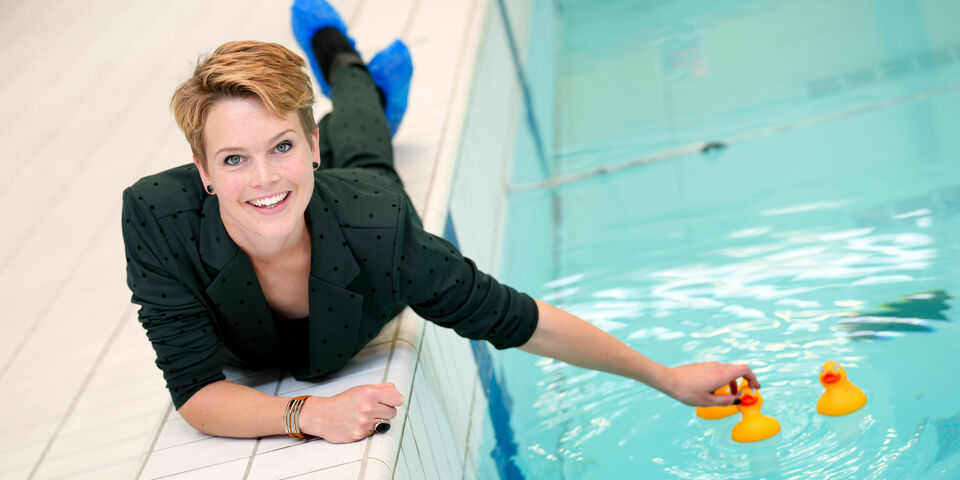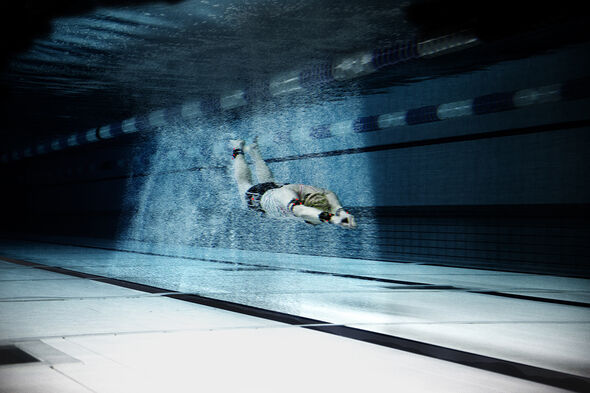Home Stretch | Moving faster through water
She took part in the Dutch National Swimming Championships and played water polo in the major league. When fluid dynamics expert Josje van Houwelingen had the chance to gain a PhD for research on the optimal swimming movement, she jumped at it. At InnoSportLab de Tongelreep she took measurements using curtains of bubbles and she taught swimmers to move to the beat.
A swimmer's relationship with the water is special, writes Josje van Houwelingen in her PhD thesis: this is because water is not only the medium against which the swimmer pushes off, it also creates the element of drag. In addition to power and stamina, the elite swimmer must have optimal technique and streamlining. “Take the position of your hands; measurements in the wind tunnel and computer simulations show that you get optimal propulsion when you spread your fingers a little.”
And because the swimmer's hands generate a large part of the propulsion, a minor change to the technique - such as the position of the fingers during the stroke - can have a substantial effect, the PhD candidate explains. “Using a rough calculation, I get half a second over the 50 meter freestyle. If you then consider that in the Olympic final at Rio, Ranomi Kromowidjojo finished in sixth place 0.12 seconds behind the winner…”
Swimming pool
In other words, small adaptations to swimming technique can have big consequences. More than enough reason to try to record the swimmers' movements - and the flow of the surrounding water - as accurately as possible. At her research group, Turbulence & Vortex Dynamics, there is plenty of experience of tracking fluid flows, Van Houwelingen tells, but unfortunately the techniques used in the lab are not directly suited to the pool.
“As a rule, we track special particles in the fluid using an incredibly fast camera. These particles are so small that they move perfectly in tune with the flow. You need a lot of light too because you are making such high-speed recordings. In the lab we use lasers, but we can't use them in a regular swimming pool and we don't want to pollute the pool water with particles. Moreover, this can put swimmers at risk.”
Article continues below picture.
Air bubbles
In the pool Van Houwelingen had to be satisfied with less accurate measurements, she explains. “I used an ‘ordinary’ high-speed camera and instead of small particles we opted for air bubbles. These are highly reactive to the flow, but they also have their own dynamics. They have a natural tendency to rise upwards through water. Still, this option is good enough to create a picture of structures in the flow. And fortunately the ambient light is all you need to illuminate the air bubbles.”
A factor that played a big part in the project's success was the decision to fit the training pool at the Pieter van den Hoogenband Swim Stadium with a double floor and double wall. “The system we used to generate the curtain of bubbles could therefore be safely tucked away in the floor, and the camera was out of harm's way in the side wall.”
LED lamp
Van Houwelingen also developed a way to measure the speed of swimmers automatically. “That involved using a simple LED lamp on the hip. This enabled us to measure how the swimmer's speed fluctuates through the stroke cycle.” Ideally, this speed is as constant as possible, explains the PhD candidate: “As resistance increases quadratically with speed, at the same average speed you experience more resistance if during any part of the stroke the speed is substantially greater than during the rest of the cycle.”
With the help of the taped-on LED lamps, Van Houwelingen carried out tests in which the swimmers had to synchronize the movements of their arms and legs with a simple rhythmic audio signal. The test subjects were exposed to the signal through a special underwater MP3 player, she explains. “Instead of a tiny receiver in your ear, there'd be one fixed to your jawbone near your ear. You hear the sound through the bone.”
Water management
Because the speed measurements are relatively simply, and the swimmers proved perfectly able to adjust their stroke rhythm to these audio signals, the researcher sees possibilities for applying this technique in training sessions. For the curtain of bubbles, the situation is more complicated. “We have proved that it works in principle, but in any follow-up project the system would need to be more user friendly to suit the practicalities of swimming.”
As for Van Houwelingen, next week she starts work at engineering firm Witteveen + Bos, where she will work on water management. “Again with water, but now more in the domain of civil engineering, so it is really something completely different.”



Discussion